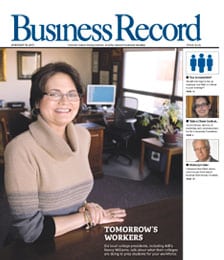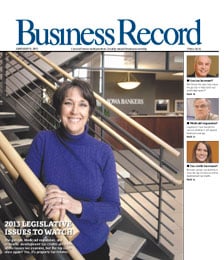Boards working harder, making more

It’s an honor to be asked, an increasing challenge to serve — and a true pleasure to be paid. Service on a board of directors of a public company in Central Iowa is far less lucrative than it is at the nation’s biggest, richest corporations, but it isn’t bad, either. In many cases, local directors make more for their part-time efforts than the average Iowan makes in a full year of work.
How well can they do? At the top of the line, you find people such as Bill Kerr, chairman and chief executive officer of Meredith Corp. Kerr, who earned about $2 million in salary and bonuses in 2003, added about $100,000 by serving on the boards of Principal Financial Group Inc. and Maytag Corp. That figure doesn’t take into account his service on boards elsewhere.
Here’s how board service compensation can add up, based on figures found in company proxy statements:
Principal and Maytag each pay non-employee board members $35,000 per year – as does Meredith — plus extra compensation for attending meetings and serving as a committee chairperson. Companies typically do not pay their own employees for board service.
In his role with Principal, Kerr also picked up $7,500 last year as the chair of the Human Resources Committee and $2,500 for attending each day of a board meeting.
At Maytag, where Kerr served on both the Audit and Compensation committees, he earned $1,250 for each board meeting attended in person, $1,250 for attending a committee meeting and $750 for taking part in a committee meeting by telephone.
And that’s just the cash part of the compensation packages. At Maytag, directors receive an option grant to buy 3,000 shares of common stock on the day after the annual stockholders meeting. As of March 16, 2004, Kerr held stock-based holdings of 25,244 shares. According to the company’s proxy report, one current Maytag director will receive an annual pension equal to her annual retainer of $35,000 after retiring from the board or reaching the age of 70. Another director assigned his pension rights to his spouse, who will receive $15,000 per year. The plan has been terminated, however, excluding all other current and future Maytag directors.
At Principal, each non-employee director receives $75,000 in restricted stock units upon election or re-election to the board. The Nominating and Governance Committee also can grant options, restricted stock or restricted stock units to any non-employee director at any time. After each annual meeting, each non-employee director receives options to purchase approximately $24,000 worth of Principal common stock.
Kerr, who declined to be interviewed for this article, is not typical of local board members. In Des Moines, few people serve on more than one public-company board, many of the slots are filled by people from other parts of the country and some companies pay far less than Principal, Maytag and Meredith. See the accompanying chart for details.
Kerr’s earnings as a Central Iowa director were paltry compared with the sums paid by some supersized corporations.
According to a survey of 350 major companies conducted by Mercer Human Resource Consulting and published recently by Corporate Board Member magazine, last year’s median figure — half were higher, half lower — for direct board member compensation, including long-term incentive grants, was $129,712.
That still doesn’t tell the whole story. The magazine reported that direct compensation to each board member at Tenet Healthcare Corp. last year was $606,552; at Brinker International Inc., the parent company of the Chili’s and Romano’s Macaroni restaurant chain, it was $870,921; and at insurance giant Aetna Inc., the best-paying board found by the researchers, each board member raked in $1.3 million.
When Jack Taylor heard that last number, he probably spoke for nearly everyone when he joked, “I would consider (serving on the Aetna board) if asked.”
BIG RESPONSIBILITIES COME WITH THE JOB
Instead, Taylor picks up an annual $15,000 retainer by serving on the Casey’s General Stores Inc. board of directors. Taylor, the chairman and CEO of Taylor Construction Group, has been on the Casey’s board for nearly 10 years and has seen the job change dramatically. “It’s harder to find people now,” he said. “There’s a greater commitment required and an exposure to risk that wasn’t as relevant 10 years ago.”
Directors say the potential for headaches has increased noticeably, regardless of the company’s size, because of the increased demands placed on boards by federal regulations, in particular the Sarbanes-Oxley Act of 2002. Taylor is the chair of Casey’s Audit Committee, which complicates his role. A few years ago, “an Audit Committee meeting was kind of perfunctory, because we had an auditing firm to handle things,” he said. “In today’s new accounting world, all audit committees have taken on a whole new level of responsibility.”
All of which suggests that director compensation probably is headed up. Mercer’s research found that overall compensation rose 15.5 percent from 2002 to 2003, but compensation in the form of long-term incentives decreased, mostly due to stock price declines or cutbacks in the use of stock options. The trend for several years has been to make cash a larger percentage of director compensation.
“I think in the next couple of years, due to strengthened regulations and increased responsibility, we’ll see more money tied to board membership,” said Inchul Suh, a professor of finance at Drake University who researches corporate finance and governance. “It’s very hard to find qualified directors nowadays. Directors have huge pressure coming from shareholders to make sure they won’t have another Enron [scandal]. As a result, a lot of companies are finding it hard to fill their boards.”
One factor in their favor: Corporate boards set their own compensation levels.
At EMC Insurance Group Inc., “We discuss compensation once a year, “ said David Fisher, the president of Onthank Co. and a board member at EMC, Wellmark Health Plan of Iowa and Chamnes Technology in Blairsburg. “Pay for meetings was raised a year ago to $1,200 from $900. I don’t think the board had increased compensation for three or four years before that.”
In reference to the comparatively modest pay levels seen at many Central Iowa companies, Fisher said, “I think it has a lot to do with the region and the culture of Iowa companies. A lot of these companies have a large contingent of Iowa stockholders, and they’re good stockholders. They hold management’s feet to the fire and wouldn’t tolerate excessive board fees.”
Fisher knows only too well that financial compensation isn’t just a reward for expending time and effort, but for facing risk, too. He was on the United Federal Savings Bank board when that institution was swept up in the savings and loan crisis.
“Board members are what the stockholders go after,” Fisher said. “Your personal resources can be put at risk. I spent two years and lot of legal fees in that UFS deal.
“Most companies will indemnify board members to a certain extent if they act in a reasonable and prudent manner,” he said. “But that’s a big issue in the world of serving on boards, putting all your assets at risk. That’s why large companies have to pay large fees to get people to serve on the board.”
LOOKING FOR NEW BLOOD
How do you find the right candidates? “I’ve been on selection committees,” Fisher said. “Usually you’ll solicit names from current board members, and you might ask around the community and around Iowa for good candidates.”
But as the competition for directors ratchets upward, a company has the option to call in professional help for a nationwide search.
“We use two national search firms,” said Marty Ketelaar, vice president of investor relations at AmerUs Group Co., a Des Moines-based insurer. “We have used Russell Reynolds Associates [based in Chicago] for a number of years, then we decided to broaden a bit and added Spencer Stuart Management Consultants [based in New York] within the past year or 18 months just to see more of the talent out there.”
The process works like this: When a vacancy approaches, the Nominating and Corporate Governance Committee of the board asks the search firms to provide names of people who match the board’s needs. “We’re always looking for people with a heavy emphasis on finance, but we might also want someone who’s strong on strategy or information technology, for example,” Ketelaar said. The search firms provide lists of prospective board members to the committee, and a couple of rounds of interviews follow. Eventually, a candidate is chosen, appointed to the board and placed on the ballot at the next stockholders meeting. Once elected, a new board member meets with key company officers to learn as much as possible about the insurance business and AmerUs’ strategy.
At Heidrick & Struggles International Inc. in Chicago, one of the nation’s largest corporate recruiters, a company spokesman said the fee for conducting a director search depends on several factors, including the size of the company. He said the search fee for a large-cap company — like Principal — is in the $100,000 range.
Several forms of training are available for new and veteran board members. Naturally, none of them come cheap. For example, The Conference Board Inc. offers one-day sessions that cost up to $4,000 for an individual. An entire board can sign up for a one-year deal, giving each of the directors the right to take one class, for a fee of $22,000.







